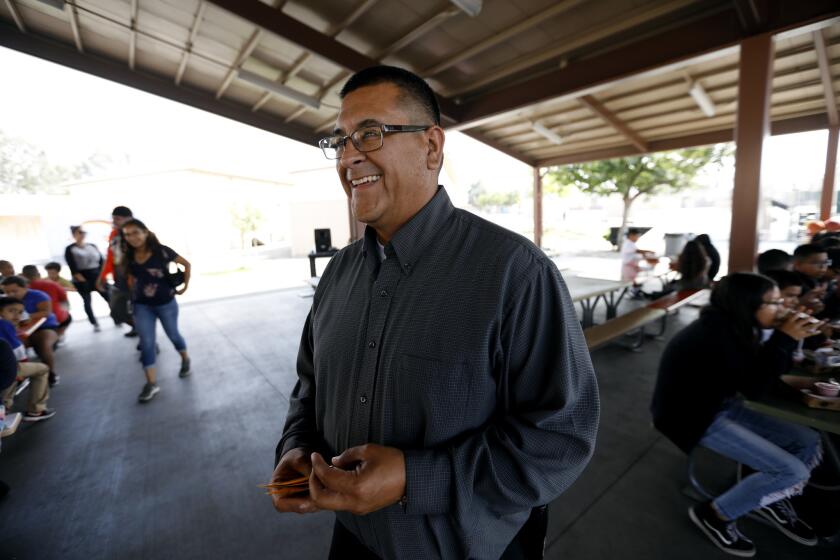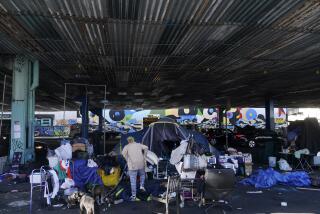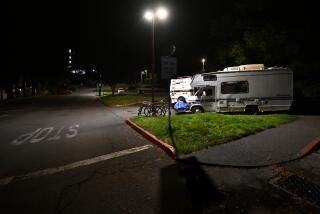California’s homeless students could fill Dodger Stadium 5 times, study finds

There were at least 269,000 K-12 students in California experiencing homelessness at the end of the 2018-19 school year — enough children and teens to fill Dodger Stadium five times over — and that number was likely a gross underestimate, a UCLA report said.
In the face of pandemic-related job losses and economic instability, researchers believe that the number of homeless students in California is likely to surge, according to the study from UCLA’s Center for the Transformation of Schools.
The report, released Wednesday, asserts that the networks of schools, school districts and local organizations that act as safety nets for these students continue to be vastly under-resourced, contributing to disproportionately poor outcomes for pupils impacted by unstable housing.
“Given that we have more students than in any other state in the country, we don’t have the systems and resources in place ... to address this issue,” said Joseph Bishop, Director at UCLA’s Center for the Transformation of Schools and coauthor of the study.
The report considers perspectives from over 150 students, educators, homeless liaisons, community-based organizations and school districts throughout the state.
The study found that the growing needs presented by homeless students — a population in California that has grown by 48% over the last decade — far outweigh the professional capacity available to address them. In L.A. County alone, more than 68,000 students were identified as homeless during the 2018-19 school year.
Federal law mandates that all school districts designate a homeless liaison who can serve as an advocate for students experiencing homelessness. Liaisons interviewed by researchers said that they “frequently struggle to prioritize the educational success of homeless students, given the number of students they are serving and the complexity of student needs,” the report said.
Despite the federal rule to help homeless students, two-thirds of children in California attend schools with no federal aid to address the consequences of homelessness, the report said.
Erin Simon, assistant superintendent of school support services for Long Beach Unified School District, said that her district’s homelessness liaison is responsible for ensuring that homeless students are identified and that teachers and other staff are trained to address their needs.
“It’s a lot,” said Simon, who served as her district’s liaison last year. “Especially now, because it’s difficult to even connect with many of our families. We don’t know where they are.”
Levi Deatherage, manager of the Family Assistance Program, a local shelter and outreach organization in San Bernardino, said he didn’t know that his high school had a liaison when he himself was struggling with homelessness.
“We are expecting these young people to operate at a level of productive thinking and foresight that is really difficult to maintain when you are actively focused on survival,” he said.
One in five community college students, one in 10 California State University students and one in 20 University of California students are also impacted by homelessness, according to the report.
Homelessness leads to dire impacts on student learning and success, researchers wrote. Compared to non-homeless students, students experiencing homelessness are twice as likely to be suspended or chronically absent, have a lower high school graduation rate, and are half as likely to be prepared to attend state universities.
Students of color are disproportionately affected by homelessness. Though Latino students make up 54% of California students, they comprise 70% of students in the state who are experiencing homelessness, the study found. Likewise, black students represent 9% of this demographic but make up 5% of the student population.
LGBTQ students also experience high rates of homelessness and housing insecurity due to family rejection.
Because many educators have not received adequate training around homelessness, they may rely on stereotypes that lead to unhoused students feeling overlooked, misunderstood and isolated, the report said. These students also often struggle to find mentors.
The report urges schools, community-based organizations, and county and state agencies to coordinate efforts in order to create an integrated response “aimed at disrupting cyclical patterns of homelessness.”
Many California school systems have already modified services in response to the COVID-19 pandemic, researchers found. These efforts include transportation assistance, delivery of learning materials, and providing meals and hygienic supplies.
For example, L.A. Unified School District has established 60 “grab and go” centers that provide two meals each day to students and families.
“We have to take collective action,” said UCLA professor of education Tyrone Howard. “Schools for far too long have been asked to solve this problem all alone.”
More to Read
Start your day right
Sign up for Essential California for news, features and recommendations from the L.A. Times and beyond in your inbox six days a week.
You may occasionally receive promotional content from the Los Angeles Times.








